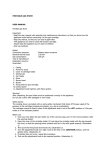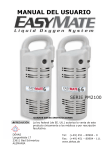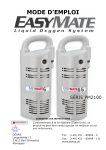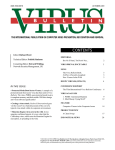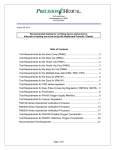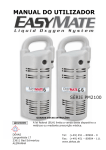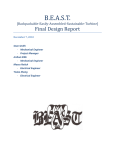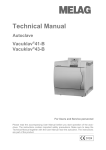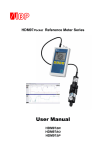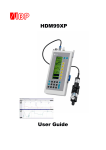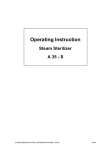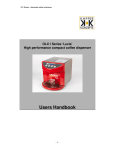Download USER MANUAL - DEHAS Medizintechnik & Projektierung GmbH
Transcript
USER MANUAL PM2100 SERIES SAVE THESE INSTRUCTIONS Federal (USA) law restricts this device to sale by or on the order of a physician. DEHAS Langenfelde 17 23611 Bad Schwartau GERMANY Tel: (+49) 451 – 80904 - 0 Fax: (+49) 451 – 80904 - 111 www.dehas.de CONTENTS RECEIVING / INSPECTION 1 INTENDED USE 2 READ ALL INSTRUCTIONS BEFORE USING 2 EXPLANATION OF ABBREVIATIONS 2 SAFETY SYMBOL DESCRIPTION 2 SPECIFICATIONS 6 PRINCIPLES OF OPERATION 7 PORTABLE SYSTEM DESCRIPTION 7 OPERATING INSTRUCTIONS 8 • FILLING THE PORTABLE SYSTEM FROM THE RESERVOIR 8 • CHECKING THE APPROXIMATE AMOUNT OF LIQUID OXYGEN REMAINING 10 • BREATHING FROM THE PORTABLE SYSTEM 11 • POSITIONING DEVICE 12 • USING THE CARRY BAG 13 • STRAP POSITIONS FOR CARRY BAG 13 TROUBLESHOOTING 14 CLEANING 16 MAINTENANCE 16 REPLACEMENT PARTS 16 RETURNS 16 DISPOSAL 16 LIMITED WARRANTY 17 DECLARATION OF CONFORMITY 18 RECEIVING / INSPECTION Remove DEHAS EasyMate 6 or EasyMate 6+6 Portable Liquid Oxygen System from the packaging and inspect for damage. If there is any damage, DO NOT USE and contact your equipment Provider. 1 INTENDED USE The system delivers 100% oxygen at different flow settings. It is intended to be used as ambulatory source of oxygen both inside and outside of the patient’s home. The patients would normally receive the oxygen via a nasal cannula. Indication: The DEHAS EasyMate 6 and Easy Mate 6+6 are intended to provide supplemental oxygen to patients who may have difficulty extracting oxygen from the air that they breathe. Contraindication: The device is not used for patients who cannot breathe by themselves. READ ALL INSTRUCTIONS BEFORE USING This manual instructs a user to operate the EasyMate 6 or EasyMate 6+6 Portable. This is provided for your safety and to prevent damage to the Portable. If you do not understand this manual, DO NOT USE the Portable and contact your Equipment Provider. DANGER This product is not intended as a life-sustaining or life-supporting device. EXPLANATION OF ABBREVIATIONS l/min psi mAWP PH b/min Liters per minute Pounds per square inch Maximum allowable working pressure Test pressure Breaths per minute SAFETY SYMBOL DESCRIPTION DANGER WARNING Which indicates an imminently hazardous situation which, if not avoided, will result in death or serious injury. Indicates a potentially hazardous situation which, if not avoided, could result in death or serious injury. CAUTION Indicates a potentially hazardous situation which, if not avoided, may result in minor or moderate injury. CAUTION Used without the safety alert symbol, indicates a potentially hazardous situation which, if not avoided, could result in property damage. 0482 Symbol indicates the device complies with the requirements of Directive 93/42/EWG concerning medical devices and all applicable international Standards. 2266 Symbol indicates the pressure vessel complies with the requirements of Directive 99/36/EG concerning transportable pressure equipment. 2 Safety Symbol Description continued: CONSULT ACCOMPANYING DOCUMENTS Symbol for “COVERING DEVICE WITH GARMENTS WILL PRODUCE OXYGEN ENRICHED ATMOSPHERE” 2 Symbol for “SINGLE USE” (Applies to Cannula only) Symbol for “DO NOT touch Liquid Oxygen or parts that have been in contact with Liquid Oxygen.” 5.1 OR Symbol for “Warning: High pressure oxidizing gas vigorously accelerates combustion” Symbol for Nontoxic gas 2 Symbol for “Equipment MUST be kept in a well-ventilated area at all times.” ALWAYS keep the Portable in an upright position Manufacturer Date of manufacture Symbol for “USE NO OIL” Symbol for “NO SMOKING” Prescription required operating Temperature limitations examine; check mass Humidity limitation Atmospheric Pressure limitation volume, FULL volume, HALF FULL 3 volume, EMPTY WARNING • This device is not intended for use by patients who would suffer immediate, permanent, or serious health consequences as a result of an interruption in the oxygen supply. • NEVER smoke in an area where oxygen is being administered. • NEVER use near any type of flame or flammable/explosive substances, vapors or atmosphere. • DO NOT use oils, greases, lubricants or any combustible materials on or near this product. Wash hands properly prior to usage. • DO NOT touch liquid oxygen or parts that have been in contact with liquid oxygen. Liquid oxygen is extremely cold (-297°F/-183°C). When touched, liquid oxygen, or parts of the equipment that have been carrying liquid oxygen, can freeze skin and body tissue. TO AVOID INCREASED RISK OF FIRE • Keep this equipment away from electrical appliances. Use and store Reservoir and Portable units at least 5 feet (1.52 m) from electrical appliances that may cause heat or sparks. • Keep oxygen equipment away from open flames. Use and store Reservoir and Portable at least 5 feet (1.52 m) away from equipment such as furnaces, water heaters, and stoves that may contain open flames. • Keep equipment in a well-ventilated area at all times. These devices periodically release small amounts of oxygen gas that must be ventilated to prevent buildup. DO NOT store liquid oxygen equipment in a closet, car trunk, or other confined area. DO NOT place blankets draperies or other fabrics over equipment. • High concentrations of oxygen can cause rapid burning of other substances. • ALWAYS confirm prescribed dose before administering to patient and monitor on a frequent basis. • DO NOT carry the Portable device under your clothing. These devices normally vent oxygen. Wearing a Portable device under clothing may saturate fabrics with oxygen and cause them to burn rapidly if exposed to sparks or flame. It may take several hours for oxygen levels in fabric to return to normal. • ALWAYS keep tubing or oxygen supply line away from path of walking to avoid potential trip or fall. • DO NOT use if dirt or contaminants are present on or around fill connectors on the Portable device or Reservoir. • NO OXYGEN is delivered when the Pulse/Flow Selector is at the “0” Setting. • NO OXYGEN is delivered in between settings. • Set Pulse/Flow Selector to “0” when not in use. 4 WARNING • NEVER attempt to repair or disassemble this device. Disassembling or unauthorized repair of this device could create a hazardous condition or cause equipment failure. If you have problems, questions, or are unsure if equipment is operating properly, call your Equipment Provider. • ALWAYS follow CGA P-2.7 standard, (guide for the safe storage, handling and use of Portable liquid oxygen Systems in Health Care Facilities). • This device is NOT to be used by patients who breath through their mouths (EasyMate 6+6 Models ONLY). • DO NOT use while sleeping without consulting your equipment Provider. • Prior to use on public transportation, check with Transportation Company for any restrictions on use of oxygen equipment. • DO NOT connect the Portable System to a gas source other than oxygen. Doing this will cause inhalation of hazardous substances. • The cannula is for single patient use only. CAUTION • Consistent with the recommendations of the medical community on the use of conserving devices, it is recommended that the Portable liquid oxygen System be qualified on patients in the situations it will be used (rest, exercise, sleep). • This device is designed to operate with a single lumen, adult, nasal cannula with a maximum length of 7 feet (2.13 m) or less. • Only individuals instructed and trained in its use should operate this device. • This device contains magnetic, ferrous material that may affect the results of an MRI. • DO NOT use liquid leak detector to test for leaks. • DO NOT autoclave. • DO NOT gas sterilize. • DO NOT clean with aromatic hydrocarbons. • DO NOT immerse device in any kind of liquid. • Store device in a clean area when not in use. • Only use DEHAS’s Liquid System carrying bag. • Avoid dropping the device or placing it in a position where it could fall and become damaged. • DO NOT block the outlet fitting or kink the cannula tubing when the device is in use. • Inspiratory efforts vary from patient to patient. The Portable liquid oxygen System may not be able to detect respiratory efforts of all patients. 5 SPECIFICATIONS Dimensions: (Are approximate and may vary by Model) Weight: empty Full Full (including all accessories) PM2110 5.3 lbs (2.4 kg) 7.7 lbs (3.5 kg) PM2120 5.7 lbs (2.6 kg) 8.0 lbs (3.6 kg) 8.2 lbs (3.7 kg) 8.7 lbs (3.9 kg) Depth: 4.80 in (12.19 cm) Width: 5.74 in (14.58 cm) 14.94 in (37.95 cm) Height: Operating Conditions: Temperature: EasyMate 6: EasyMate 6+6: Altitude: Storage Conditions: Temperature: Humidity: Settings: EasyMate 6 EasyMate 6+6 -4°F to 110°F (-20°C to 43.3°C) 32°F to 110°F (0°C to 43.3°C) Sea level to 10,000 ft (3048 m) -10°F to 140°F (-23°C to 60°C) 95% Non-condensing Continuous: Continuous: Pulse: 0, 0.25, 0.5, 1, 1.5, 2, 2.5, 3, 3.5, 4, 5, 6 l/min 0, L1, L2, L3, L4, L5, L6 l/min P2, P3, P4, P5, P6 l/min Equivalents Maximum Capacity: 0.95 liters Maximum Working pressure: 25 psi (1.72 bar) Cannula Requirement: Maximum 7 foot (2.13 m) long standard or high flow adult single lumen oxygen nasal cannula. Setting 0 (OFF) Pulse Volume Accuracy: (EasyMate 6+6 Models ONLY) Within ±15% of the nominal minute volume @ 20 b/min Continuous Mode Accuracy: Approximate 70°F (21°C) Setting 0.25: ± 0.125 l/min Setting 0.50: - 0.124 / + 0.25 l/min Setting 1 thru 3.5: - 0.24 / + 0.25 l/min Setting 4: - 0.24 / + 0.50 l/min Setting 5 & 6: - 0.49 / + 0.50 l/min Trigger Method: (EasyMate 6+6 Models ONLY) inspiratory effort (negative pressure from patient inhalation) Breathing frequency: (EasyMate 6+6 Models ONLY on a pulse setting) Up to 40 b/min Specifications subject to change without prior notice. 6 PRINCIPLES OF OPERATION The DEHAS Portable liquid oxygen System consists of a cryogenic liquid oxygen cylinder attached to an oxygen delivery mechanism. The conserving mechanism (if applicable), controls when a set bolus volume of oxygen gas is delivered to the patient by sensing the patient’s inspiratory effort. The fixed flow mechanism, controls the amount of continuous flow of oxygen gas in liters per a minute that is delivered to the patient. The cryogenic liquid oxygen cylinder is a stainless steel container suitable for storage of liquid oxygen at very low temperatures. PORTABLE SYSTEM DESCRIPTION CAUTION Missing or illegible labels must be replaced, contact DEHAS. cannula connection vent to Fill lever Product Serial Number Pulse / Flow Selector identification label contents Scale Warning label Fill connector condensation Pad WARNING • Read this User manual before operating the Portable. • Using a clean, dry cloth, wipe the fill connector dry on both the Reservoir and Portable System before filling to prevent freezing. 7 OPERATING INSTRUCTIONS CAUTION Inspect the EasyMate 6 or EasyMate 6+6 for visual damage before use, DO NOT USE if damaged. Filling the Portable System from the Reservoir 1. Check the contents indicator on the Reservoir to ensure liquid oxygen is available for filling purposes. When the Reservoir is low, inform your equipment Provider. 2. Remove the cannula from the Portable, if attached. 3. Remove the Portable from the carrying bag. 4. Remove protective cap on reservoir fill connector, if applicable. WARNING • DO NOT fill the Portable while it is in the carrying bag. • The Portable System is intended to be used with any compatible Reservoir with a maximum working pressure of 25 psi (1.72 bar). • The device shall not be used if the liquid oxygen connector of the Portable is not compatible with the Reservoir. 5. Use a clean, dry cloth, wipe the fill connector on the Reservoir and Portable. 6. Carefully position the Portable, ensuring that the fill connector of the Portable System aligns with the fill connector of the Reservoir. 7. Engagement: a. Connect the Portable & Reservoir by pressing down to the fill position. b. During filling, maintain a slight downward pressure on the Portable System with one hand to keep the device steady and maintain proper filling position. 8. While holding the Portable System in the fill position, pull the vent-to-fill lever to the open position (Figure 1). A hissing noise should be noticeable. Maintain a slight downward pressure on the Portable System with one hand to keep the device steady and maintain proper filling position. 9. Push the vent-to-fill lever to the closed position on the Portable System after you notice a change in the sound of venting gas followed by a dense, white vapor coming from the Reservoir cover. NOTE: The filling time is approximately 60 seconds. Figure 1 8 CAUTION If the vent-to-Fill lever fails to close and the hissing continues, remove the Portable from the Reservoir. The Portable will stop venting in a few minutes. The Portable may require as much as 30 minutes to restore normal operation. 10. Disengagement: a. Disconnect the Portable System from the Reservoir by pulling in an upright motion. Always hold the device with at least one hand when attempting to disconnect it. (Figure 2) NOTE: • It is common to hear a hissing sound after the Portable System has been filled. This is the relief valve venting excess pressure. Upon disengaging the Portable System from the Reservoir it is common to see condensation on or near the fill connector. • It is common to have a few small droplets of liquid oxygen coming from the fill connector when disengaging the Portable from the reservoir. Figure 2 CAUTION DO NOT OVERFILL Filling device longer than specified fill times can lead to OVERFILLING. Overfilling does NOT provide any advantages and can cause problems with the use of the device. Overfilling can result in a delay of 30 minutes before the Portable can be used. Releasing the vent-to-fill lever will stop the filling process. WARNING • If a liquid oxygen leak occurs at the fill connector when you disconnect the Portable, reconnect and disconnect the Portable System to help dislodge any ice or other obstruction. If the liquid leak persists, notify your oxygen supplier. DO NOT insert any foreign objects into fill connector. • If you notice a steady stream of liquid oxygen at the fill connector when you disconnect the Portable System, stay away from the device and immediately notify your oxygen supplier. • DO NOT leave the portable liquid oxygen system unattended during the filling operation. • DO NOT direct flow of oxygen at any person, or flammable material. NOTE: If the Reservoir and Portable System does not disconnect easily, they may have become frozen. Simply allow a few minutes for the frozen parts to warm and then disengage the Portable when the ice has melted. 9 11. Check the approximate oxygen contents in the Portable System using the contents scale. NOTE: The Portable liquid oxygen System will make a hissing noise when venting. This is a normal occurrence. WARNING • Never open the vent-to-fill lever when Portable System is not connected to Reservoir. • If vent-to-fill lever is inadvertently opened when not connected to Reservoir a burst of cold oxygen will be emitted. It may take as much as 30 minutes to restore to normal operation Checking the Approximate Amount of Liquid Oxygen Remaining 1. Remove cannula from Portable outlet cannula connection. 2. Remove Portable from carry bag. 3. Remove lower part of contents scale from case. Rotate Scale until it is in an upward position (Figure 3). 4. Hold the content scale with one hand, pull down on the portable with the other hand and release. This method will result in a consistent contents measurement. 5. Read the contents indicator of the scale to Figure 3 determine the approximate amount of liquid oxygen contents in the device. To ensure you have enough oxygen to meet your needs, check the indicator periodically. 6. DO NOT use contents scale for any purpose other than specified, doing so may damage the scale and void the warranty. The table below shows approximate use times for the Portable System after it has been completely filled. Your use time may vary from the use times listed below. We recommend that you learn through experience how long the Portable System will last under your circumstances. Approximate use time of a Full Portable System. Continuous Flow Setting Pulsed Flow . 0.25 - 0.50 18 Hours NA 1 12 Hours NA 1.5 9 Hours NA 2 6 Hours 18 Hours 2.5 5 Hours NA 3 4 Hours 16 Hours 3.5 3.5 Hours NA 4 3 Hours 14 Hours 5 2.5 Hours 12 Hours 6 2 Hours 11 Hours 10 Breathing from the portable System 1. Attach a standard adult single lumen oxygen nasal cannula, (no longer than 7 feet (2.13 m)) to the Portable’s cannula connection according to the cannula manufacturer’s instructions. CAUTION DO NOT use pediatric, low flow nasal cannulas or oxygen masks with this device. Continuous Flow ONLY! Settings: 0, 0.25, 0.5, 1, 1.5, 2, 2.5, 3, 3.5, 4, 5, 6 l/min Pulse & Continuous Flow Pulse Settings: P2, P3, P4, P5, P6 l/min Equivalents Continuous Settings: 0, L1, L2, L3, L4, L5, L6 l/min 2. Align the Pulse/Flow Selector to the prescribed setting (Figure 4). The Pulse/Flow setting value should be clearly visible in the center of the window. Figure 4 WARNING NO OXYGEN is delivered in between settings. Figure 5 3. Place the cannula in position by inserting the two tips into your nostrils, running the tubing over your ears and then routing the cannula as shown in (Figure 5). OR 11 4. When your Portable System is set to Pulse Setting P2 thru P6 (EasyMate 6+6 Model), oxygen will be delivered only while you inhale. You should notice a small pulse at the beginning of each breath. Oxygen is delivered during this pulse. it is normal for the device to occasionally skip a breath or to pulse twice in one breath. 5. Breathe through the nose and feel a pulse of oxygen as you inhale. 5a. When your Portable is set to a continuous setting, a constant flow of oxygen will be delivered. 6. Insert Portable System into the carry bag. WARNING Carry bag may become saturated with oxygen which could cause it to burn rapidly if exposed to sparks or flames. It may take several hours for the oxygen levels in fabric to return to normal. Figure 6 Positioning Device Always keep the Portable System in an upright position while in use, as illustrated in (Figure 6). Placing the device on its front, back or upside down will shorten the usage time of device. If the Portable is placed on its front, back or upside down (see below) for more than one (1) minute, check the liquid oxygen level in the Portable. By placing the Portable in the positions, listed below may cause a loss of oxygen, or the vent to fill lever to become too cold for filling. Set the Portable in an upright position for at least 15 minutes before attempting to fill. Front Back 12 Upside down Using the Carry bag Figure 7 illustrates how the device should be placed in its bag. Ensure the device is oriented so there are no obstructions to the cannula connection. Figure 7 Strap positions for Carry bag Figures 8 & 9 illustrate the positioning of the strap for carrying as a backpack or over the shoulder. Figure 8 Figure 9 Backpack View Shoulder View The options on how to use the carry bag with the device are illustrated below and next page (Figures 10-12). Figure 10 Figure 11 13 Figure 12b Figure 12a TROUBLESHOOTING If the Portable liquid oxygen System fails to function, consult the Troubleshooting guide below. If problem cannot be corrected, consult your Equipment Provider. Problem No pulse Probable Cause Remedy 1. Device empty. 2. Pulse/Flow Selector set to “0”. 3. Pulse/Flow Selector positioned between settings. 4. Device not sensing breath (Pulse setting ONLY). 1. 2. 5. Cannula disconnected. 6. Kinked or blocked cannula. 7. Device overfilled. 5. 6. 3. 4. 7. Refill device. Set to prescribed setting. Rotate Pulse/Flow Selector to your prescribed setting. a) Check position of cannula in nose. b) Do not breathe through mouth. Reconnect cannula. Remove kink/ obstructions, Replace cannula. Wait approximately 30 minutes until device returns to normal operating conditions. Position device upright. Set to an equivalent continuous flow setting. 8. 8. Device not in upright position. 9. 9. Conserving setting(s) defective (Pulse setting ONLY). 10. Pulse/Flow Selection 10. Set Pulse/Flow selector to prescribed setting. not set to Pulse settings. Continued on next page. 14 PROBLEM PROBABLE CAUSE REMEDY Device not filling 1. Not pulling vent-to- 1. Pull out vent-to-Fill lever. 2. Make sure fill connectors are fully engaged. 3. Contact liquid Oxygen Supplier to refill Reservoir. Unable to disconnect portable from Reservoir 1. a) Depress the release button on the Reservoir, if equipped. Fill lever. 2. Not connecting fill connectors completely. 3. Reservoir empty. 1. Fill connectors frozen from moisture on fill connectors. b) Allow time for device to warm. NOTE: If during this time liquid oxygen begins to leak from device, keep away and contact your Equipment Provider. Device frosted & no pulse or continuous flow 1. Device overfilled. 1. Wait approximately 30 minutes until Device returns to normal operating conditions. Device is making a 1. Device was just filled. 1. Start using Device. 2. Device was turned on 2. Hissing should reduce hissing noise, (venting) its side. in a few seconds. 3. Patient is not using 3. Device will continue to NOTE: VENTING IS device after filled. vent until depleted. NOT A LEAK! (This is a normal operation) WARNING • • For oxygen dependent patients (24 hours a day treatment) a secondary oxygen supply should be available all the time during therapy. If primary oxygen supply fails to supply adequate oxygen, secondary oxygen supply should be employed for proper oxygen delivery. 15 CLEANING 1. As needed, clean exterior of the Portable with a clean, lint free cloth dampened with water. Allow device to dry prior to use. 2. Store Portable in a clean area free from grease, oil, and other sources of contamination. Condensation pad (As needed): 1. Remove condensation Pad from case. 2. Wash with a mild detergent and rinse thoroughly with water. Allow Condensation Pad to completely dry. 3. When condensation Pad is dry, push pad back into case. WARNING • • • • DO NOT allow water into any of the controls, or the fill connector. DO NOT use cleaning solutions. DO NOT immerse device in any kind of liquid. DO NOT use alcohol, solvents, polishes, or any oily substance on oxygen equipment. MAINTENANCE ATTENTION: Equipment Provider This device contains several field serviceable components. Contact DEHAS customer Service to obtain service procedures and related service items. REPLACEMENT PARTS Description Part # Cannula 504833 Carry bag 506869 Condensation Pad 506797 RETURNS Returned products require a Returned goods Authorization (RGA) number. To obtain an (RGA) number, contact DEHAS. All returns must be packaged in sealed containers to prevent damage. The Portable device must be fully depleted of liquid oxygen prior to shipping. DEHAS will not be responsible for goods damaged in transit. Refer to DEHAS Return Policy available on the internet, www.dehas.de/Englisch/impressum_agb.htm Manuals are available on request at [email protected]. DISPOSAL Dispose of the Portable liquid oxygen System in accordance with the local regulations. Please Recycle 16 LIMITED WARRANTY AND LIMITATION OF LIABILITY DEHAS Medizintechnik & Projektierung GmbH warrants that the DEHAS liquid oxygen System (the Product) and the following component parts thereof will be free of defects in workmanship and/or material for the following period: EasyMate liquid oxygen System Vessel vacuum one (1) year from date of shipment Five (5) years from date of shipment This limited warranty does not cover: 1) Normal routine service items, 2) Defects due to the wear and tear caused by mating components, 3) Repair or replacement necessitated by misuse, abuse, or accident. Replacement parts or repaired products shall be free from defects in workmanship and materials for the duration of the unexpired portion of the original warranty or ninety (90) days from the date of reshipment, whichever is longer. Should any failure to conform to this warranty appear within the applicable period, DEHAS shall, upon written notification thereof and substantiation that the goods have been stored, installed, maintained and operated in accordance with DEHAS´s instructions, operational verification procedures, and standard industry practice, and that no modifications, substitutions, or alterations have been made to the goods, shall, in its discretion, and at its own expense, repair or replace the defective component(s). ORAL STATEMENTS DO NOT CONSTITUTE WARRANTIES AND THERE ARE NO WARRANTIES OTHER THAN AS SET FORTH IN THIS CONTRACT. Neither the representative of DEHAS nor any retailers are authorized to make oral warranties about the merchandise described in this contract, and any such statements shall not be relied upon and are not part of the contract for sale. This writing is a final, complete and exclusive statement of the terms of the contract and sale. DEHAS disclaims any warranty of merchantability, fitness for a particular purpose or any other warranty of quality, whether express or implied except as set forth above. DEHAS shall not under any circumstances be liable for special, incidental or consequential damages including but not limited to lost profits, lost sales, or injury to person or property. Correction of non-conformities as provided above shall constitute fulfillment of all liabilities of DEHAS whether based on contract, negligence, strict tort or otherwise. DEHAS reserves the right to discontinue manufacture of any product or change product materials, designs, or specifications without notice. DEHAS reserves the right to correct clerical or typographical errors without penalty. 17 DECLARATION OF CONFORMITY DEHAS Medizintechnik GmbH Langenfelde 17 23611 Bad Schwartau GERMANY EasyMate Portable Liquid Oxygen Systems: 0482 PM 2100 Series Classification: IIb Classification criteria: Clause 3.2 Rule 11 of Annex IX of MDD We herewith declare that the above mentioned products meet the provisions of the following EC Council Directives and Standards. All supporting documents are retained under the premises of the manufacturer and the notified body. Directives: General Application Directives: (MDD) Medical Device Directive, Council Directive 93/42/EEC Of 14 June 1993 Concerning Medical Devices, Directive 2007/47/EC Of The European Parliament and of the Council of 5 September 2007 and 99/36/EC Transportable Pressure Equipment Directive 1999. Applied Standards: ISO 15223-1:2012 EN 1041 BS EN 1251-1 BS EN:1251-2 BS EN:1251-3 BS EN 1418 BS EN:1626 BS EN:1797-1 BS EN:12300 EN ISO 14971 ISO 15001 ISO 7000 BS EN 60601-1-2 BS EN 60601-1-6 BS EN ISO 15614-1 BS EN ISO 18777 Notified Body: Medcert GmbH / 0482 Address: Pilatuspool 2, 20355 Hamburg; GERMANY Certification Registration No’s: 4153GB43411109 Devices already manufactured: SN traceability via Device History records Validity of DOC: 01/ 2013 to Date of Expiry Notified Body for Pressure Equipment: DEKRA Automobil GmbH/ Certification Registration No’s: Z-O-02609898/13 Manufacture Representative: Quality Manager Position: Manager, Quality System/ISO Representative Date of Issue: 26/February/2013 Date of Expiry: 11/2016 2266 Handwerkstraße 15, 70565 Stuttgart 18 DEHAS Medizintechnik & Projektierung GmbH Langenfelde 17 23611 Bad Schwartau, GERMANY Tel: (+0049) 451-80904-0 (+001) 610-462-8204 Fax: (+0049) 451-80904-111 (+001) 610-262-6080 Tell us how we are doing! Visit us at www.dehas.de 506746 Rev3 02/26/13

























